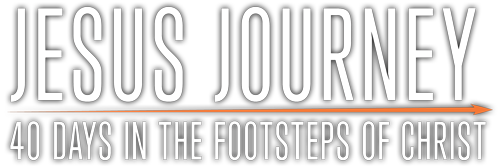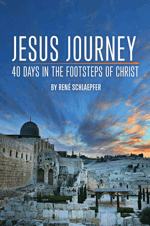Day 36
The Mystery of Jesus’ Death Cry
Ancient stone steps wind down into Jerusalem from the ruins of the high priest’s mansion on the slopes of Mount Zion. While archaeologists argue over the exact location of Annas and Caiaphas’ first century homes, on this they agree: Jesus likely walked down these very steps as he was led to face Pontius Pilate for his final trial. Ultimately, these steps took Jesus to the cross.
As I stand here, our guide Kenny tells me how Neil Armstrong, the first man to walk on the moon, visited Jerusalem in 1988. He had become a devout believer, and asked his guide to take him to a place where it was certain Jesus had walked.
Armstrong stood on these very steps and seemed to go into deep prayer. His guide asked him what he was feeling, and the former astronaut said: “This is the greatest moment of my life. It means more to me to walk on these steps than to walk on the moon.”
As I place my hand on the weathered stone steps, I close my eyes and think of what Jesus must have been feeling. Down this slope Christ walked to his final trial before Pilate, and from there to the cross.
Surely he felt a deepening dread of the death he knew awaited him at Golgotha.
THE CRY OF THE CROSS
My mind goes to Calvary. One sentence Christ spoke there has confused many Christians over the centuries:
“My God, my God, why have you forsaken me?”
When I was in college, I had an atheist professor who had been a Jesuit priest. He told me one of the things that rocked his faith was his belief that, at this moment, Jesus himself lost his faith.
Is that what was happening?
I’m convinced Jesus was directing the few followers who had returned to be near the cross to an amazing prophecy he wanted them to remember.
SONG OF THE CROSS
The national songbook of Israel was the Psalms. They were all written hundreds of years before Christ. Every Jew knew them. But in those days, the Psalms were not numbered. They were known by their first line — that served as their title.
The first line of Psalm 22?
“My God, my God, why have you forsaken me?”
Why would Jesus, hanging on a cross in agony, be quoting the first line to a song?
Because often, when someone quotes you the opening lyrics to a song, you instantly remember the rest of it, right?
“In the town… where I was born….” (“Lived a man who sailed the sea” you are probably thinking)
“Oh, say can you see…” (“By the dawn’s early light…”)
Christ was calling out the title to a song that he wanted his followers to recall.
But again, why would he do that? Read it for yourself. It’s eerie. Psalm 22 sounds like it was written by an eyewitness of the crucifixion — until you realize it was composed ten centuries before Christ was born!
Just a few verses from Psalm 22:
All who see me mock me;
they hurl insults, shaking their heads.
“He trusts in the Lord,” they say,
“let the Lord rescue him.” Psalm 22:7–8
(See Matthew 27:41–44)
I am poured out like water,
and all my bones are out of joint.
My heart has turned to wax;
it has melted within me. Psalm 22:14
(See John 19:33–34)
My mouth is dried up like a potsherd,
and my tongue sticks to the roof of my mouth. Psalm 22:15
(See John 19:28)
…a pack of villains encircles me;
they pierce my hands and my feet. Psalm 22:16
(See John 19:36–37)
They divide my clothes among them
and cast lots for my garment. Psalm 22:18
(See John 19:23–24)
And it goes on. Psalm 22 predicts about a dozen details of Jesus’ crucifixion about a thousand years before they happened. David (the author of Psalm 22) lived about 1043–973 BC.
And get this: These details were written in Psalm 22 about seven hundred years before crucifixion was developed. That’s all strong evidence for me that the Bible was literally inspired by God. And that Jesus really was the promised Messiah.
PAID IN FULL
Psalm 22 starts grimly, but ends with hope, with a prophecy that the furthest reaches of the earth will turn back to the Lord. And then here’s the last line of the psalm. Ready for some more goose bumps?
“He has done it!”
(Psalm 22:31). Another way to translate that phrase? “It is finished!”
It’s the last thing Jesus shouts from the cross, according to John 19:30. The Greek word John used for “finished,” tetelestai, is an interesting word. It’s an accounting term that people in the first century would put on their bills to indicate “paid in full!”
Jesus wasn’t saying, “I am finished!” He was saying, “My act on your behalf is finished. Your debt has been paid.”
Picture your sin. The sin that still haunts you with guilt. The one you’re trying to atone for.
Now picture next to it the phrase: paid in full. Do you grasp the grace?
It’s not up to you to prove your worth or earn God’s favor. You just receive what Jesus paid in full through his death on the cross.
PURPOSEFUL PAIN
Don’t get me wrong. I think Jesus was experiencing devastating emotions on the cross. In crying out loudly to God, “Why have you forsaken me?” he was sending a message to us: I know how much life can hurt.
That’s so good to hear. Because at times of great sorrow I have cried out, God, what are you doing? Where are you? Why have you left me? When I feel like that, Jesus is not unsympathetic.
He gets it. He’s been there himself.
But in the midst of his pain, he was also reaching out to those he loves, wanting to show them a prophecy about the very events that were unfolding before their eyes!
In doing so he was also sending another message to them, and to us: I did this on purpose!
He went to the cross because that is why he came. God came to pay your debt. In full.
THE FINAL BARRIER DESTROYED
And in a bookend to his description of the heavens being “torn open”
at Christ’s baptism, the gospel writer Mark now repeats that word at the culmination of Christ’s ministry.
The curtain of the temple was torn in two from top to bottom. Mark 15:38
From top to bottom. From God to us. Listen to the first-century writer Josephus’ description of that veil:
It was a Babylonian curtain, embroidered with blue, and fine linen, and scarlet, and purple, and of a texture that was truly wonderful. Nor was this mixture of colors was not without its mystical interpretation, but was a kind of image of the universe… 44
So the veil being torn was an image of the heavens being opened.
This is why he came: The separating veil between a holy God and sinful man is ripped apart, through the sacrifice of Christ Jesus, in whom the two came together, the God-man.
When I survey the wondrous cross
On which the Prince of Glory died,
My richest gain I count but loss,
And pour contempt on all my pride.
Were the whole realm of nature mine,
That were a present far too small;
Love so amazing, so divine,
Demands my soul, my life, my all. — Isaac Watts
Project
Write down on a piece of paper — being as creative as you want to be — the phrase “paid in full.” Place the paper somewhere you’ll see it daily and be reminded that’s the truth about you because of Jesus.

 Buy Jesus Journey at Amazon.com
Buy Jesus Journey at Amazon.com